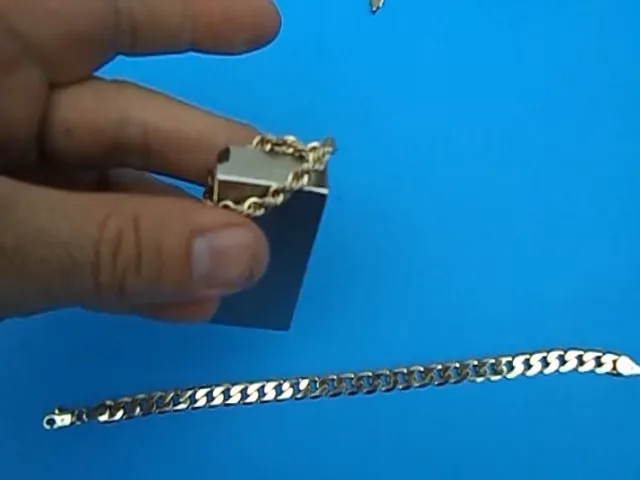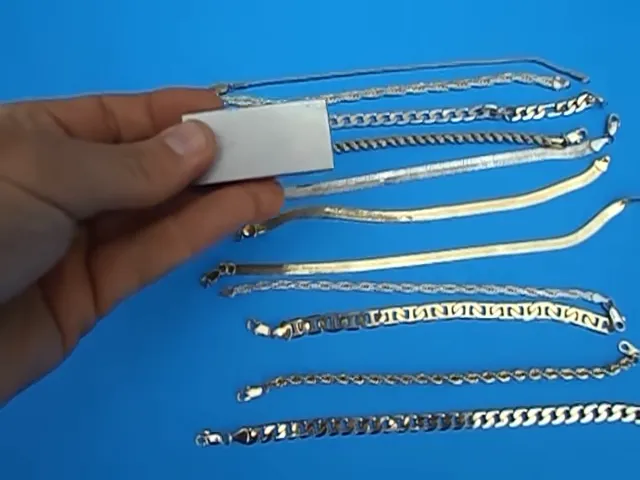Gold, a symbol of wealth and beauty for millennia, holds a fascination in its luster and rarity. But when it comes to distinguishing real gold from its imitations, a common query arises: does fake gold exhibit magnetic properties? This question is rooted in the unique characteristics of gold and the science of magnetism, which are often misunderstood or oversimplified.
Real gold, due to its specific elemental properties, does not stick to a magnet. Being a non-ferrous metal, it is not attracted to magnets. In contrast, many materials used to create fake gold can exhibit magnetic properties. This difference provides a simple, though not entirely foolproof, method for testing the authenticity of gold.
Gold’s allure is often marred by the presence of counterfeit versions masquerading as the real deal. These fakes can vary widely in composition, some containing magnetic metals which respond to magnets, while others are made of non-magnetic materials that mimic gold’s appearance. Understanding these properties not only aids in identifying real gold but also reveals fascinating insights into the world of metallurgy and materials science.
### Magnetism and Metal Interaction
In the realm of precious metals, understanding how magnetism interacts with different materials is crucial, especially when discerning the authenticity of gold. Magnetism, a fundamental force of nature, affects various metals in distinct ways. This interaction becomes a pivotal point in identifying real gold from its imitations.
### Gold and Magnetism
#### Basic Properties of Gold
Gold, a chemical element with the symbol Au (from Latin: aurum), is renowned for its remarkable resistance to corrosion and oxidation. Its atomic number is 79, placing it among the heavier atomic elements that occur naturally. In its purest form, gold exhibits a bright yellow color, though it can appear in different hues depending on the alloys present.
#### Understanding Magnetism
Magnetism, at its core, is a physical phenomenon produced by the motion of electric charge, resulting in attractive and repulsive forces between objects. All materials exhibit some magnetic properties due to the motion of electrons in their atoms. However, the extent and type of magnetic behavior vary significantly across different materials.
#### How Magnetism Affects Different Metals
Metals respond to magnetic fields in three primary ways: ferromagnetic, paramagnetic, and diamagnetic. Ferromagnetic metals like iron, nickel, and cobalt are strongly attracted to magnets. Paramagnetic metals, including platinum and aluminum, are weakly attracted, while diamagnetic materials like copper and gold are weakly repelled.
### Fake Gold and Magnetism
#### Composition of Fake Gold
Fake gold, often found in jewelry and decorative items, can be composed of various metals. Commonly used materials include brass, copper, nickel, and iron-based compounds. These materials are selected to mimic the appearance and weight of gold, though they lack its chemical and physical properties.
#### Magnetism in Common Fake Gold Materials
Many materials used to create fake gold exhibit magnetic properties, particularly if they contain iron or nickel. This magnetic response can be a clear indicator of counterfeit gold, as real gold is diamagnetically repelled by magnets.
### Testing Gold Purity with Magnets
#### Simple Magnet Test Explanation

The magnet test for gold purity is straightforward. By bringing a strong magnet close to the gold item, one observes the reaction. If the item is attracted to the magnet, it indicates the presence of ferromagnetic metals, suggesting the gold is not pure.
#### Limitations of the Magnet Test
While useful, the magnet test has its limitations. It cannot detect non-magnetic metals mixed with gold, nor can it determine the exact purity of gold. Additionally, some sophisticated fake gold materials may pass the magnet test, necessitating further analysis.
#### Additional Methods to Verify Gold Purity
To accurately assess gold purity, additional methods are employed. These include:
– Acid tests, where different strengths of acid are used to test gold purity.
– Electronic gold testers, which measure conductivity.
– X-ray fluorescence spectrometers, providing a non-destructive analysis.
### Factors Influencing Magnetism in Gold
#### Impurities in Gold
Gold’s purity, or lack thereof, significantly influences its magnetic properties. Impurities, often in the form of other metals mixed with gold, can alter its reaction to magnetic fields. These impurities are common in lower karat gold, affecting both its value and magnetic behavior.
#### Alloy Composition and Magnetic Response
Alloys, created by mixing gold with other metals, change its physical properties, including its response to magnets. For instance, white gold, often alloyed with nickel, may exhibit slight magnetic properties due to the presence of nickel.
#### Examples of Magnetic and Non-Magnetic Alloys
Examples of magnetic gold alloys include those mixed with iron or nickel, which respond to magnetic fields. In contrast, non-magnetic alloys, such as those mixed with silver or copper, maintain a diamagnetic response, similar to pure gold. Understanding these variations is essential in the jewelry industry and for individual consumers seeking authenticity in their gold purchases.
—
In the next section of this article, we’ll explore the visual and technical methods for identifying fake gold, debunk common myths surrounding gold and magnetism, and offer practical advice for prospective gold buyers. Stay tuned for an in-depth look at these fascinating aspects.
### Fake Gold Identification
The identification of fake gold is an art as much as it is a science. With the prevalence of counterfeit gold products, it’s important for consumers and professionals alike to understand how to differentiate real gold from imitations.
### Visual Inspection Techniques
Visual inspection is often the first line of defense in identifying fake gold. This involves closely examining the gold item for specific indicators that suggest authenticity or counterfeit. Some key aspects to look for include:
– **Color and Luster**: Genuine gold has a distinct bright yellow hue. While some fake gold can mimic this color, it often lacks the same depth and richness of luster.
– **Surface Marks and Wear**: Gold is a soft metal; thus, genuine gold items often show signs of wear, especially on older pieces. Fake gold, made from harder materials, may not show these wear patterns.
– **Craftsmanship**: High-quality craftsmanship is often a hallmark of genuine gold jewelry. Imperfections in design or finish can be indicators of counterfeit pieces.
### Weight and Density Tests
The weight and density of an item can be revealing indicators of its authenticity:
– **Weight Test**: Gold is a dense metal. Counterfeit gold items made of lighter metals will feel lighter than an equivalent-sized piece of real gold.
– **Density Calculation**: This involves measuring the volume and weight of the item to calculate its density. The density of pure gold is 19.32 g/cm³, and significant deviations from this value suggest the presence of other metals.
### Hallmarks and Certification
Hallmarks and certification play a crucial role in verifying the authenticity of gold:
– **Hallmarks**: Genuine gold items are often stamped with hallmarks that indicate their purity, origin, and manufacturer. Common gold hallmarks include 10K, 14K, 18K, 22K, and 24K.
– **Certification**: Certificates of authenticity from reputable sources can confirm the purity and quality of gold items. It’s important to verify the credibility of these certificates.
### Common Myths About Gold and Magnetism
There are numerous myths surrounding gold and its interaction with magnets, which can lead to confusion and misinformation.
### Debunking Popular Misconceptions
One common misconception is that any magnetic reaction automatically means the gold is fake. While it’s true that pure gold is not magnetic, gold alloys can contain magnetic metals, giving them a slight magnetic pull without necessarily being counterfeit.
### Real vs. Perceived Magnetism in Gold
Understanding the difference between real and perceived magnetism in gold is key:
– **Real Magnetism**: This occurs when gold is alloyed with magnetic metals like iron or nickel. In such cases, the gold item may exhibit a weak magnetic response.
– **Perceived Magnetism**: Sometimes, external factors, such as a magnetic clasp in jewelry, can give the illusion that the gold itself is magnetic. It’s essential to isolate the gold part of the item for accurate testing.
—
### Practical Tips for Gold Buyers
Purchasing gold, whether for investment or adornment, requires careful consideration and knowledge. Buyers should equip themselves with practical tips and tricks to ensure they are making informed decisions and getting genuine value for their money.
### How to Conduct a Magnet Test

The magnet test is a simple yet effective tool for initial gold authenticity checks. Here’s how to conduct it properly:
1. **Use a Strong Magnet**: A fridge magnet won’t suffice. Use a neodymium magnet, which is much stronger and more effective in detecting ferrous materials.
2. **Clean the Gold Item**: Ensure the gold piece is clean of any dirt or debris that might affect the test’s outcome.
3. **Isolate the Gold**: If the gold is part of jewelry, ensure that other materials (like clasps or settings) do not influence the test.
4. **Gently Bring the Magnet Close**: Slowly move the magnet towards the gold. Watch for any sign of attraction. Remember, real gold should not be attracted to the magnet.
### Questions to Ask When Buying Gold
When purchasing gold, asking the right questions can help you determine the authenticity and quality of the item:
– **Ask about the Gold’s Purity**: Inquire about the karat rating of the gold. The higher the number, the purer the gold.
– **Request Proof of Authenticity**: Ask if the gold comes with certification or any proof of authenticity.
– **Inquire About Refund and Return Policies**: Understanding the seller’s policies on refunds and returns can provide an additional safety net.
– **Discuss the Gold’s Origin**: Knowing where the gold was sourced can provide insights into its quality and ethical considerations.
### Importance of Buying from Reputable Sources
Purchasing gold from reputable sources is paramount. Trusted jewelers and dealers are more likely to provide high-quality, authentic gold and are accountable to trade associations and regulations. They often offer certifications and detailed information about their products, increasing buyer confidence.
### Summary of Key Points
To summarize, understanding gold’s properties, especially in relation to magnetism, is crucial in distinguishing real from fake gold. The magnet test, while a useful preliminary tool, should be complemented with other methods like weight and density tests, visual inspection, and professional appraisal for a more comprehensive assessment.
### Importance of Comprehensive Testing
Comprehensive testing ensures that buyers are getting what they pay for. Using a combination of tests provides a more accurate and reliable understanding of the gold’s authenticity and purity. This is particularly important in scenarios where high-value transactions are involved or when the gold’s purity is critical, such as in investment-grade gold.
### Encouraging Informed Gold Purchases
Educated gold purchases not only protect buyers from fraud but also enhance the overall market integrity. By understanding the nuances of gold testing and asking the right questions, buyers can make informed decisions, ensuring their investment is sound and their adornments genuine. This knowledge empowers consumers, fostering a more transparent and trustworthy gold market.
—
Continuing further, we will delve into the nuances of gold’s allure, its role in different cultures, and the future of gold in the global economy. These insights will provide a broader understanding of gold’s place in our world, both as a precious metal and a cultural symbol. Stay tuned for a deep dive into the fascinating world of gold.
Will a magnet stick to plated gold?
No, a magnet will not typically stick to gold-plated items if the underlying metal is non-magnetic. Gold plating involves applying a very thin layer of gold over another metal. If the base metal is non-magnetic, such as copper or silver, the gold-plated item will not be attracted to a magnet. However, if the underlying metal is magnetic, such as iron or nickel, the magnet may stick to the gold-plated item because of the magnetic properties of the base metal, not the gold plating itself.
It’s important to remember that while this can be a quick test to check for ferrous metals, it’s not definitive for assessing the purity or quality of gold plating, as the gold layer itself is non-magnetic regardless of the purity.
Can fake gold be non magnetic?
Yes, fake gold can be non-magnetic. Fake or counterfeit gold items are often made from a variety of non-magnetic materials that imitate the appearance of gold. Common non-magnetic materials used in fake gold include:
– **Brass**: An alloy of copper and zinc, brass closely resembles gold in appearance but is non-magnetic.
– **Copper**: This metal has a reddish color but can be alloyed or coated to look like gold, and it is non-magnetic.
– **Aluminum**: Lightweight and non-magnetic, aluminum can be colored to look like gold.
– **Gold-Plated Metals**: Various metals, including non-magnetic ones, can be gold-plated. The thin layer of gold on the surface gives the appearance of real gold while the underlying metal can be something entirely different.
These materials do not have magnetic properties, so a magnet test alone is not sufficient to determine the authenticity of gold. Other tests, such as acid tests, density tests, and professional appraisals, are necessary to accurately identify real gold.
### Frequently Asked Questions
#### Does Real Gold Stick to Magnets?
No, real gold does not stick to magnets. Gold is a non-ferrous metal, meaning it does not contain iron, which is required for magnetic attraction. This characteristic helps distinguish real gold from many common counterfeits.
#### Can Magnetism Test Determine Gold Purity?
While a magnet can identify ferrous metals mixed in gold, it cannot determine gold purity. Other testing methods like acid tests or electronic gold testers are needed to accurately measure gold purity.
#### What Metals Commonly Used in Fake Gold Are Magnetic?
Common metals used in fake gold that are magnetic include iron and nickel. These are often mixed with other metals to replicate the appearance of gold, but their magnetic properties give them away.
#### How Reliable Is the Magnet Test for Gold?
The magnet test is a good starting point but not entirely reliable. Some non-magnetic materials can also be used to create fake gold, so passing the magnet test does not guarantee gold’s authenticity.
### Conclusion
In sum, the relationship between gold and magnetism is a key tool in identifying real versus fake gold. Real gold’s lack of magnetic attraction provides a simple yet powerful way to verify authenticity. However, it is important to use this test in conjunction with other methods, as it is not foolproof.
The science behind gold and magnetism is as fascinating as it is practical. By understanding the basic principles of metallurgy and magnetism, one can make more informed decisions when purchasing or testing gold.
Lastly, in the realm of gold, knowledge is indeed as valuable as the metal itself. Discerning buyers and curious minds alike benefit from understanding the subtle differences between real gold and its imitations, ensuring both smart purchases and an appreciation for this timeless element.

